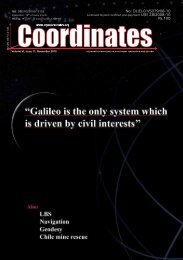Download - Coordinates
Download - Coordinates
Download - Coordinates
Create successful ePaper yourself
Turn your PDF publications into a flip-book with our unique Google optimized e-Paper software.
to me that geodesy could be described as<br />
an Earth Observation (EO) discipline, or<br />
science. Certainly the classical definition<br />
of geodesy does not make clear that it is an<br />
EO science which has broader functions<br />
and applications, and potentially more<br />
relevance, than just as a foundation for<br />
mapping and surveying. It struck me<br />
that we must acknowledge that classical<br />
geodesy narrowly defined from this<br />
perspective of surveying and mapping<br />
needs to make way for Modern Geodesy.<br />
So what sets geodesy (and the IAG)<br />
apart from other EO disciplines? The<br />
answer came to me some years ago.<br />
It is the fact that the IAG has fostered<br />
the establishment of “services” to<br />
provide fundamental products for many<br />
geoscientific and geospatial end-users.<br />
As president of the IAG I am especially<br />
proud to acknowledge the important work<br />
of these services. The services include the<br />
International VLBI (Very Long Baseline<br />
Interferometry) Service (IVS – http://<br />
ivscc.gsfc.nasa.gov), the International<br />
Laser Ranging Service (ILRS – http://ilrs.<br />
gsfc.nasa.gov), the International DORIS<br />
(Doppler Orbitography & Radiopositioning<br />
Integrated by Satellite) Service (IDS<br />
– http://ids.cls.fr) and the best known,<br />
the International GNSS Service (IGS<br />
– http://igs.org). Through another IAG<br />
service – the International Earth Rotation<br />
& Reference Systems Service (IERS<br />
– http://www.iers.org) – these space<br />
geodetic techniques play a critical role<br />
in defining the fundamental reference<br />
frame in relation to which changes in<br />
the location of points on (or above) the<br />
earth’s surface (including satellite orbits),<br />
or the shape of the land, or level of the<br />
ocean surface, can be monitored over<br />
many years to sub-centimetre accuracy.<br />
Therefore special mention should be made<br />
of one of the IAG’s “flagship” products<br />
– the International Terrestrial Reference<br />
Frame (ITRF – http://itrf.ensg.ign.fr) –<br />
which also increasingly is the basis for<br />
modern national mapping datums.<br />
The IAG also has established the<br />
International Gravity Field Service (IGFS<br />
– http://www.igfs.net) to measure and<br />
model the earth’s gravity field to high<br />
accuracy using, for example, sophisticated<br />
gravity mapping satellite missions such as<br />
CHAMP, GRACE and GOCE. Gravimetric<br />
geodesy can nowadays measure changes<br />
in gravity acceleration arising from mass<br />
transport (which changes gravity by tiny<br />
amounts) due to the global water cycle,<br />
atmospheric and ocean circulation, and<br />
solid earth processes such as volcanism<br />
and tectonics. Amazing technology!<br />
All the IAG services generate products on<br />
a continuous basis. These products may be<br />
the primary outputs of geodetic analysis,<br />
such as precise coordinates of GNSS<br />
monitor stations, or global meteorological<br />
values of humidity, temperature and<br />
pressure, or maps of ionospheric<br />
disturbances, rate of rotation of the earth,<br />
orientation of its rotation axis, and many<br />
others. Such products can be used directly<br />
by many scientists. In addition, indirect<br />
products such as the reference frame,<br />
precise orbits of EO satellites, precise<br />
timing scales and high-accuracy GNSS-<br />
<strong>Coordinates</strong> November 2011 | 9

















